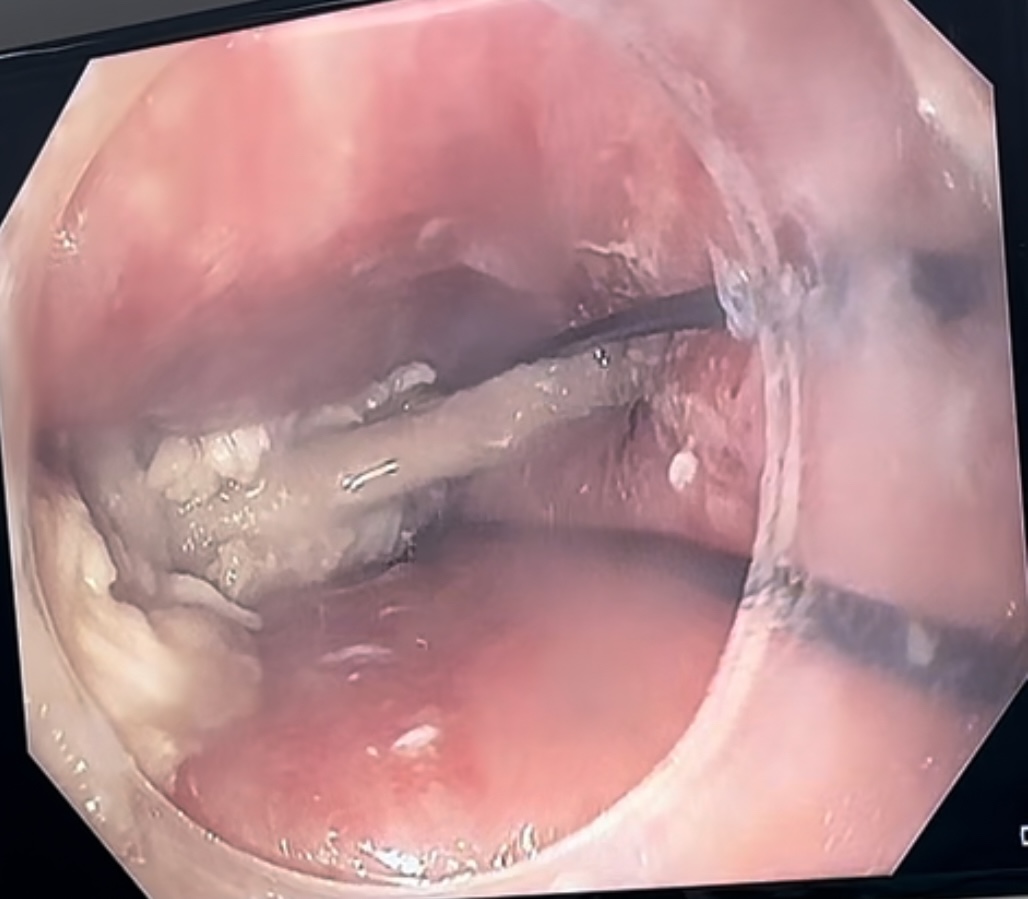Sunday Poster Session
Category: General Endoscopy
P0868 - Mechanical Lithotripsy Triumph: Resilient Endoscopic Management for Chicken Bone Impaction, Dodging Thoracic Surgery
Sunday, October 26, 2025
3:30 PM - 7:00 PM PDT
Location: Exhibit Hall

Maniel A. Ruiz-Ramos, MD (he/him/his)
San Juan City Hospital
San Juan, PR
Presenting Author(s)
Maniel A. Ruiz-Ramos, MD1, Belissa Lopez-Peña, MD1, Javier Cerra-Franco, MD, ABIM-GI, AEFT2
1San Juan City Hospital, San Juan, Puerto Rico; 2Hospital Menonita Cayey, San Juan, Puerto Rico
Introduction: Foreign body (FB) impaction in adults is most often due to accidental food ingestion but may be influenced by factors such as age, intoxication, psychiatric illness, or illicit drug concealment. While many cases resolve without intervention, 10–20% require endoscopic removal. The esophagus’s natural narrowings make it a common site of impaction, and clinical history with imaging guides urgency and choice of retrieval technique. Standard endoscopic tools such as snares, forceps, nets, and overtubes may be ineffective in more complex cases. We present the novel application of a mechanical lithotriptor, typically used for gallstone fragmentation, in managing a difficult esophageal FB impaction, avoiding surgical intervention.
Case Description/
Methods: A 62-year-old male with hypertension and benign prostatic hyperplasia presented with acute dysphagia after ingesting roasted chicken. He reported two prior self-resolved impactions. He was hemodynamically stable but endorsed retrosternal discomfort. Chest X-ray was unremarkable; neck CT identified a 4 cm chicken bone at the C7–T1 level, lodged in the proximal thoracic esophagus with partial wall penetration but no perforation. Upper endoscopy revealed an impacted food bolus at 18 cm, successfully removed using rat-tooth forceps. A horizontally oriented bone at 20 cm resisted multiple retrieval attempts using forceps, snares, and a Roth net, causing superficial mucosal trauma. A 0.038-inch guidewire was looped around the bone and secured to a mechanical lithotriptor. Under direct visualization, the bone was fragmented and safely extracted endoscopically. Residual debris was cleared or advanced into the stomach. The patient remained NPO post-procedure, and a gastrografin esophagram confirmed no perforation.
Discussion: Management of FB impactions depends on object characteristics, location, and patient factors. When conventional techniques fail, surgical intervention may be considered, increasing the risk of complications like bleeding, infection, and prolonged recovery. This case illustrates that mechanical lithotripsy, although traditionally used for biliary stones, can serve as a safe, minimally invasive option for difficult esophageal FB extraction. Limited literature exists on its use for non-biliary FBs, but emerging cases support its utility. Success relies on close coordination among gastroenterology, radiology, anesthesia, and nursing teams. Innovative approaches like this can optimize outcomes and reduce reliance on surgery in GI emergencies.

Figure: A approximately 20cm piece of bone, horizontally oriented and lodged in the esophageal wall with an evident traction mucosal tear

Figure: Visualization of a coronal view of neck CT evidence of bony foreign body in esophagus at level of C7
Disclosures:
Maniel Ruiz-Ramos indicated no relevant financial relationships.
Belissa Lopez-Peña indicated no relevant financial relationships.
Javier Cerra-Franco indicated no relevant financial relationships.
Maniel A. Ruiz-Ramos, MD1, Belissa Lopez-Peña, MD1, Javier Cerra-Franco, MD, ABIM-GI, AEFT2. P0868 - Mechanical Lithotripsy Triumph: Resilient Endoscopic Management for Chicken Bone Impaction, Dodging Thoracic Surgery, ACG 2025 Annual Scientific Meeting Abstracts. Phoenix, AZ: American College of Gastroenterology.
1San Juan City Hospital, San Juan, Puerto Rico; 2Hospital Menonita Cayey, San Juan, Puerto Rico
Introduction: Foreign body (FB) impaction in adults is most often due to accidental food ingestion but may be influenced by factors such as age, intoxication, psychiatric illness, or illicit drug concealment. While many cases resolve without intervention, 10–20% require endoscopic removal. The esophagus’s natural narrowings make it a common site of impaction, and clinical history with imaging guides urgency and choice of retrieval technique. Standard endoscopic tools such as snares, forceps, nets, and overtubes may be ineffective in more complex cases. We present the novel application of a mechanical lithotriptor, typically used for gallstone fragmentation, in managing a difficult esophageal FB impaction, avoiding surgical intervention.
Case Description/
Methods: A 62-year-old male with hypertension and benign prostatic hyperplasia presented with acute dysphagia after ingesting roasted chicken. He reported two prior self-resolved impactions. He was hemodynamically stable but endorsed retrosternal discomfort. Chest X-ray was unremarkable; neck CT identified a 4 cm chicken bone at the C7–T1 level, lodged in the proximal thoracic esophagus with partial wall penetration but no perforation. Upper endoscopy revealed an impacted food bolus at 18 cm, successfully removed using rat-tooth forceps. A horizontally oriented bone at 20 cm resisted multiple retrieval attempts using forceps, snares, and a Roth net, causing superficial mucosal trauma. A 0.038-inch guidewire was looped around the bone and secured to a mechanical lithotriptor. Under direct visualization, the bone was fragmented and safely extracted endoscopically. Residual debris was cleared or advanced into the stomach. The patient remained NPO post-procedure, and a gastrografin esophagram confirmed no perforation.
Discussion: Management of FB impactions depends on object characteristics, location, and patient factors. When conventional techniques fail, surgical intervention may be considered, increasing the risk of complications like bleeding, infection, and prolonged recovery. This case illustrates that mechanical lithotripsy, although traditionally used for biliary stones, can serve as a safe, minimally invasive option for difficult esophageal FB extraction. Limited literature exists on its use for non-biliary FBs, but emerging cases support its utility. Success relies on close coordination among gastroenterology, radiology, anesthesia, and nursing teams. Innovative approaches like this can optimize outcomes and reduce reliance on surgery in GI emergencies.

Figure: A approximately 20cm piece of bone, horizontally oriented and lodged in the esophageal wall with an evident traction mucosal tear

Figure: Visualization of a coronal view of neck CT evidence of bony foreign body in esophagus at level of C7
Disclosures:
Maniel Ruiz-Ramos indicated no relevant financial relationships.
Belissa Lopez-Peña indicated no relevant financial relationships.
Javier Cerra-Franco indicated no relevant financial relationships.
Maniel A. Ruiz-Ramos, MD1, Belissa Lopez-Peña, MD1, Javier Cerra-Franco, MD, ABIM-GI, AEFT2. P0868 - Mechanical Lithotripsy Triumph: Resilient Endoscopic Management for Chicken Bone Impaction, Dodging Thoracic Surgery, ACG 2025 Annual Scientific Meeting Abstracts. Phoenix, AZ: American College of Gastroenterology.
